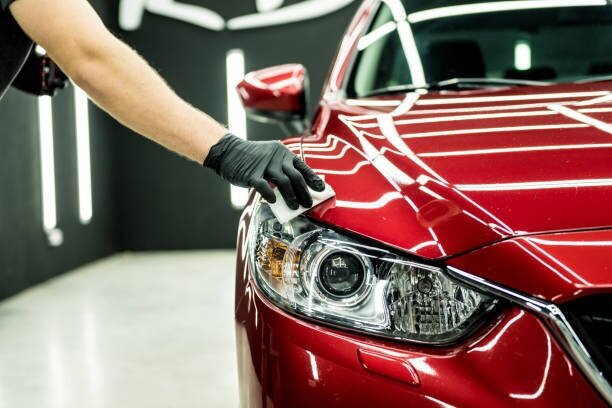Exactly How Outlining Porcelain Layer Enhances the Longevity of Your Cars and truck's Paint
Ceramic layer has emerged as a crucial technology in automobile detailing, using a long-lasting remedy for protecting the integrity of your cars and truck's paint. Recognizing the complexities of exactly how ceramic layer works and its benefits over typical wax can give useful insights for auto proprietors.
What Is Ceramic Covering?
Comprehending the safety benefits of ceramic covering starts with acknowledging its composition and functionality. Ceramic coating is a liquid polymer applied to the external surface areas of automobiles, mainly developed to boost and shield automotive paint (Conforti Auto and Marine Detailing Ceramic Coating).
The layer's application involves careful preparation of the vehicle's surface area, which need to be free from contaminants, scratches, and flaws to make sure ideal bond. Once used, the ceramic finish remedies to form an inflexible shield that can withstand various environmental factors, consisting of UV rays, chemical spots, and oxidation.
Moreover, ceramic layers are not simply surface-level therapies; they pass through the paint to give an enduring defense. This capability prolongs the life-span of the vehicle's visual appeals while preserving its value gradually. Understanding these basic aspects of ceramic coating is essential for cars and truck owners looking for effective services for paint conservation and improvement.
Benefits of Ceramic Finish
The advantages of ceramic finish extend far beyond its basic safety attributes - Conforti Auto and Marine Detailing Ceramic Coating. One of the most substantial benefits is its capability to give extraordinary resilience. Unlike standard wax or sealants, ceramic coatings create a solid bond with the cars and truck's paint, allowing it to hold up against ecological threats such as UV rays, acid rainfall, and roadway salt. This strength substantially decreases the danger of paint damages, preserving the lorry's aesthetic allure.
In addition, ceramic coatings supply hydrophobic homes, implying they fend off water and pollutants. This particular not only makes the car easier to clean however likewise minimizes the regularity of washing, saving both time and initiative for cars and truck owners. The slick surface created by the layer stops dirt and crud from adhering, boosting the vehicle's overall cleanliness.
In addition, ceramic finishes enhance the depth and clarity of the paint, giving vehicles a shiny surface that is visually striking. This visual enhancement further adds to preserving the cars and truck's resale value, as a well-kept exterior is a major selling factor for prospective buyers. On the whole, the advantages of ceramic finishing make it a worthwhile financial investment for anyone looking to protect and boost their vehicle's paintwork.
Just How Ceramic Covering Functions

The coating's hydrophobic homes fend off water and dust, preventing the buildup of grime on the surface. This not only makes the automobile simpler to clean yet likewise minimizes the likelihood of scratches and swirl marks triggered by conventional cleaning approaches. In addition, the ceramic layer works as a guard versus UV rays, which can cause fading and oxidation in time.
When treated, the coating exhibits impressive resistance to chemicals, including roadway salts, bird droppings, and tree sap, which can or else harm the paint. The longevity of ceramic coverings can last for numerous years, relying on factors such navigate to this website as upkeep and environmental problems. On the whole, the chemical bonding procedure of ceramic coatings supplies a durable protection that maintains the stability and appearance of a vehicle's paintwork.
Comparing Ceramic Finishing to Wax
Comparing ceramic layer to conventional wax discloses considerable differences in performance and longevity. While both items intend to secure a car's paint, their make-ups and sturdiness set them moved here apart. Wax, commonly made from all-natural carnauba or synthetic materials, gives a short-term guard that generally lasts just a couple of weeks to a few months, depending upon ecological conditions and upkeep routines.
In comparison, ceramic coverings are sophisticated remedies composed of inorganic products that bond chemically with the vehicle's paint. This produces a durable, semi-permanent layer of protection that can endure for a number of years. Consequently, ceramic coverings provide premium resistance to UV rays, chemical stains, and physical abrasion, dramatically minimizing the risk of oxidation and fading.
Additionally, the hydrophobic buildings of ceramic finishes make sure that water grains up and rolls off the surface, making it harder for dirt and crud to stick. This convenience of cleansing is a remarkable advantage over wax, which can bring in dust and call for regular reapplication. Eventually, for cars and truck proprietors looking for durable defense and improved visual allure, ceramic layers offer an extra reliable choice to typical wax products.
Upkeep Tips for Long Life
Correct maintenance is vital for taking full advantage of the durability of a ceramic coating. Make use of a pH-balanced learn this here now auto hair shampoo to stop breaking down the finish, and prevent automatic automobile washes with severe brushes that can cause micro-scratches.
To preserve the hydrophobic properties of the ceramic layer, consider using a maintenance spray or booster especially created for ceramic finishings every couple of months. This will reinforce the safety layer and improve water beading.
Furthermore, avoid exposing the coated surface to extreme environmental conditions whenever feasible. Car parking in shaded locations or using a car cover can protect against UV damage and contamination from bird droppings, tree sap, or industrial results.
Last but not least, evaluate the layer regularly for indicators of wear or damage. If you see a decrease in hydrophobic behavior, it may be time for a professional reapplication. By sticking to these maintenance suggestions, vehicle owners can dramatically expand the life and efficiency of their ceramic layer, guaranteeing that their auto's paint remains secured and aesthetically appealing for years ahead.
Conclusion
